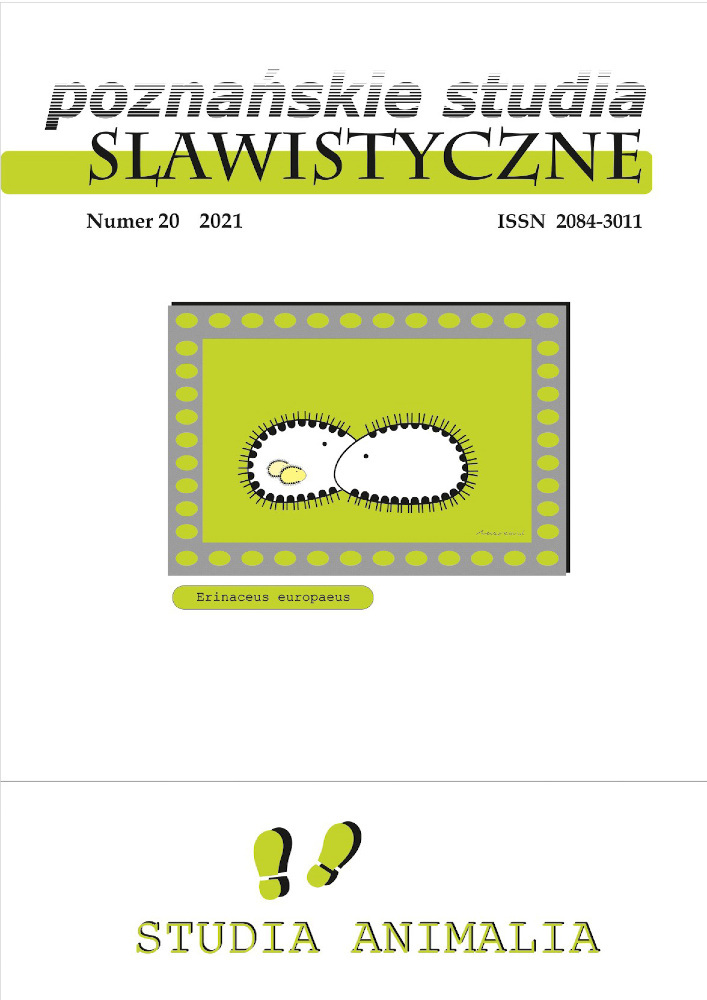Abstract
The article shows what role the writing instruments, in particular wax tablets, used by St. Cyril the Philosopher, could play in shaping the material form of Glagolitic writing. In this research approach, writing is treated not only as a system of abstract signs, but also as their factual figure formed by a tool on a writing material. In the case of the Glagolitic alphabet, its creation was therefore both a mental and physical process involving objects such as wax tablets. The ease of engraving the shapes of new letters on a soft surface and the possibility of repeatedly erasing them allowed Cyril to experiment with their forms without consuming valuable parchment. Therefore, this process depended mainly on the material properties of the wax produced by honeybees, which was used to cover the wooden tablets designed for writing with a stylus. In this way, these insects participated in the creation of the material dimension of Slavic writing, on a par with people who took the stick from them, choosing the wax from the hives to further process it. This proves that Cyril did not force the Glagolitic letters formed in his mind onto passive material, but that beeshaped, writing wax affordances actively cooperated in this process.
References
Aicher, O. (2016). Świat jako projekt. Przeł. R. Darda-Staab, I. Dębek. Red. nauk. pol. wyd. A. Siemes, M. Wszołek. Wrocław: Wydawnictwo Libron.
Bischoff, B. (1990). Latin Palaeography. Antiquity & the Middle Ages. Trans. D.O. Cróinin, D. Ganz. Cambridge: Cambridge University Press. https://doi.org/10.1017/ CBO9780511809927.
Bodei, R. (2016). O życiu rzeczy. Przeł. A. Bielak. Łódź: Wydawnictwo Przypis.
Breasted, J. H. (1916). The Physical Processes of Writing in the Early Orient and Their Relation to the Origin of the Alphabet. „The American Journal of Semitic Languages and Literatures” vol. 32, no. 4, s. 230–249. https://doi.org/10.1086/369798.
Čunčić, M. (2012). Granice geometrije i simbolike u glagoljskoj paleografiji. „Slovo: časopis Staroslavenskoga instituta u Zagrebu”. http://bib.irb.hr/datoteka/335643. Cuncic_Granice_geometrije_i_simbolike_u_glagoljskoj_paleografiji.pdf. 14.11.2020.
Czernorizec Chrabr (2013). O piśmie. Przeł. A. Naumow. W: Święci Konstantyn-Cyryl i Metody patroni Wschodu i Zachodu, t. I: Apostołowie Słowian w dawnej Europie. Oprac. zespół pod red. A. Naumowa, Kraków: Collegium Columbianum, s. 33–36.
Dahl, S. (1965). Dzieje książki. Przeł. A. Garbacik i in. Wrocław–Warszawa–Kraków: Zakład Narodowy im. Ossolińskich.
Dain, A. (1949). Les manuscrits. Paris: Les Belles-Lettres. https://doi.org/10.4000/books.lesbelleslettres.11395.
Engelmann, R. (1896). Hellada i Roma. Życie Greków i Rzymian, t. I. Przeł. S. Mieczyński, Warszawa: Nakładem Gebethnera i Wolffa.
Fawcet, N., Zietsman, J. (2001). Uluburun – The Discovery and Excavation of the World’s Oldest Known Shipwreck. „Akroterion” no. 46, s. 5–20. https://doi. org/10.7445/46-0-116.
Flusser, V. (2018). Kultura pisma. Z filozofii słowa i obrazu. Przeł. i posłowiem opatrzył P. Wiatr. Warszawa: Wydawnictwo Aletheia.
Gadamer, H.-G. (1993). Prawda i metoda. Przeł. B. Baran. Kraków: inter esse. Gekeler, W. (2014). Pszczoły. Poradnik hodowcy. Warszawa: Wydawnictwo RM.
Houston, K. (2017). Książka. Najpotężniejszy przedmiot naszych czasów zbadany od deski do deski. Przeł. P. Lipszyc. Kraków: Wydawnictwo Karakter.
Horodyński, B. (1951). Podręcznik paleografii ruskiej. Kraków: Wydawnictwo Studium Słowiańskiego Uniwersytetu Jagiellońskiego.
Ingold, T. (2018). Splatać otwarty świat. Wyb. i oprac. E. Klekot. Kraków: Instytut Architektury.
Jansen, M. S. (1980). The Homeric Question and the Oral-Formulaic Theory. Copenhagen: Museum Tusculanum Press.
Krąpiec, M. A. (1968). Materia i forma. Ich różne rozumienie w historii filozofii. „Roczniki Filozoficzne” t. XVI, z. 1, s. 55–65.
Latour, B. (2010). Splatając na nowo to, co społeczne. Wprowadzenie do teorii aktora- -sieci. Przeł. A. Derra, K. Abriszewski. Kraków: Universitas.
Merleau-Ponty, M. (2001). Fenomenologia percepcji. Przeł. M. Kowalka, J. Migasiński, posł. J. Migasiński. Warszawa: Fundacja Aletheia.
Noordzij, G. (2014). Kreska. Teoria pisma. Przeł. M. Komorowska. Kraków: d2d.pl.
Norman, D. (2018). Dizajn na co dzień. Przeł. D. Malina. Kraków: Karakter.
Nowe tablice, czyli o cerkwi, liturgii, nabożeństwach i utensyliach cerkiewnych. Objaśnienia Beniamina arcybiskupa Niżnego Nowogrodu i Arzamasy. Wybór. (2007). Przeł. I. Pietrov. Kraków: Wydawnictwo Uniwersytetu Jagiellońskiego.
Obolenski, D. (1971). Byzantine Commonwealth Culture and Slavs. Eastern Europe, 500–1453. New York: ACLS Humanities.
Olsen, B. (2013). W obronie rzeczy. Archeologia i ontologia przedmiotów. Przeł. B. Shallcross. Warszawa: Instytut Badań Literackich PAN.
Pietkiewicz, K. (2015). Paleografia ruska. Warszawa: DiG.
Ramachandran, V. S. (2012). Neuronauka o podstawach człowieczeństwa. Warszawa: Wydawnictwo Uniwersytetu Warszawskiego. https://doi.org/10.31338/ uw.9788323529507.
Reed, R. (1975). The Nature and Making Parchment. Leads: Elmete Press.
Roberts, C. H., Skeat, T. C. (1982). The Birth of the Codex. Oxford: Oxford University Press.
Roffet-Salque, M., Regert, M., Evershed, R. P. (2015). Widespread exploitation of the honeybee by early Neolithic farmers. „Nature” no. 527, s. 226–230. https://doi. org/10.1038/nature15757.
Rosińska, Z. (2020). Nie tylko to co racjonalne. Teksty z filozofii kultury. Warszawa: Oficyna Naukowa.
Sanford, M. T., Dietz, A. (1976). The Fine Structure of the Wax Gland of the Honey Bee (Apis mellifera). „Apidologie” no. 7 (3), s. 197–207. https://doi.org/10.1051/ apido:19760301.
Santifaller, L. (1953). Beiträge zur Geschichte der Beschreibstoffe im Mittelalter Mit Berücksichtigung der päpstlichen Kanzlei. Graz-Köln: Böhlaus Nachf.
Sławski, F. (1991). Święci Cyryl i Metody – życie i dzieło. W: Cyryl i Metody apostołowie i nauczyciele Słowian. Red. J.S. Gajek MIC, L. Górka SVD, Lublin: Redakcja Wydawnictw Kul, s. 23–34.
Small, J. P. (1997). Wax Tablets of the Mind. Cognitive studies of memory and literacy in classical antiquity. London – New York: Routledge.
Walewska, K. (1960). Wosk pszczeli. W: Słownik towaroznawczy, t. 9. Warszawa: Polskie Wydawnictwo Gospodarcze, s. 255–268.
Wolf, F. A. (1795). Prolegomena Ad Homerum: Sive De Operum Homericorum Prisca Et Genuina Forma Variisque Mutationibus Et Probabili Ratione Emendandi. Halis Saxonum: E. Libraria Orphanotrophei.
Wójtowicz, M. (2000). Początki pisma słowiańskiego. Poznań: Wydawnictwo Naukowe UAM.
Zimbardo, P. (1999). Psychologia i życie. Warszawa: PWN.
Джурова, А., (1997). Въведение в славянската кодикология. София: Център за славяно-византийски проучвания „Иван Дуйчев”.
[Dzhurova, A. (1997). Vavedenie v slavyanskata kodikologiya. Sofiya: Centar za slavyano-vizantiyski prouchvaniya „Ivan Duychev”].
License

This work is licensed under a Creative Commons Attribution 4.0 International License.

